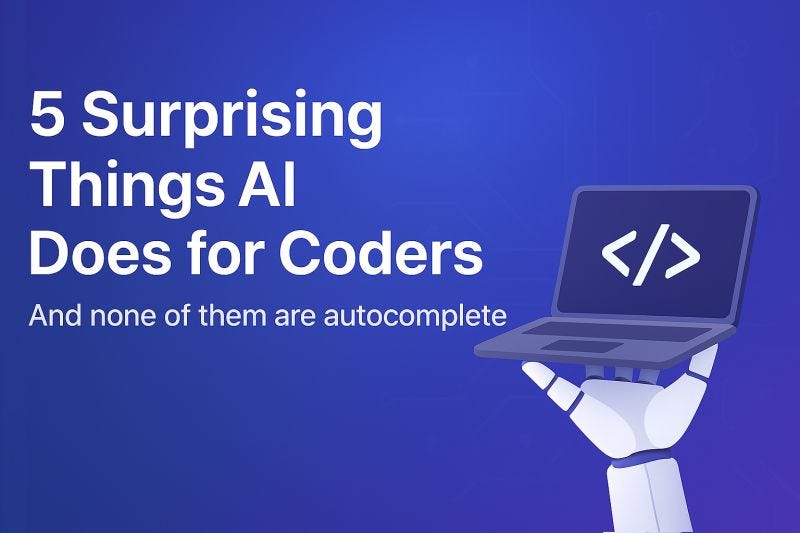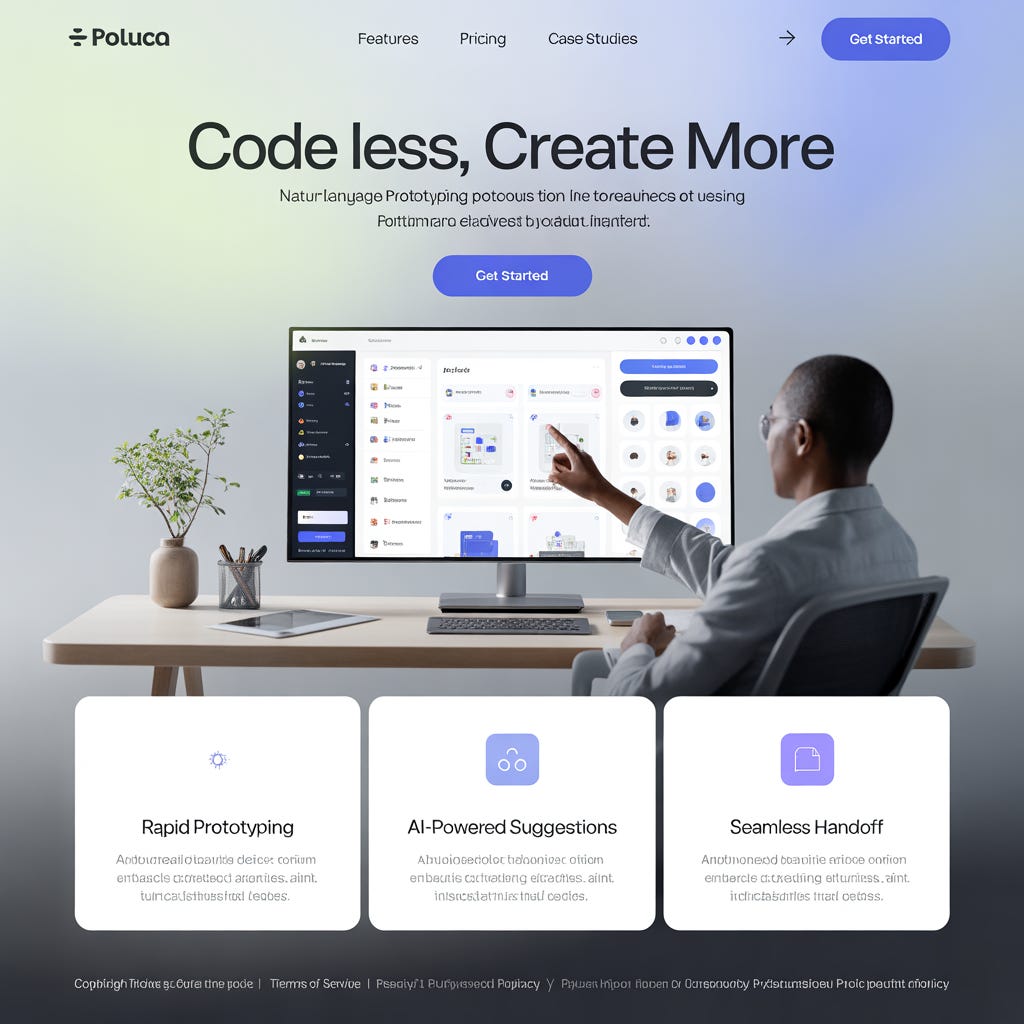Beyond Autocomplete: 5 Surprising Ways AI Supercharges Your Development Workflow
From automated code reviews to UI prototypes and data cleanup, discover how modern AI tools free developers to focus on creativity.
Introduction
Not long ago, I thought “AI for coding” meant fancy autocomplete. You know — you type half a line and a co‑pilot fills in the rest. Cool, helpful, but nothing that would fundamentally change how I build software. Then I started playing with a few tools and realised I’d been sitting on a goldmine.
Recent research shows that AI adoption touches nearly every stage of the software‑development lifecycle. In a 2025 survey of more than 400 teams, 67 % of developers already use AI for code generation, while documentation and test creation each have roughly 65 % adoption. Yet merge approvals and other bottlenecks remain mostly human‑controlled. This uneven adoption highlights that AI isn’t just about writing code; it’s about automating the repetitive work that keeps us from focusing on creativity and problem solving.
Below are five tasks I’ve happily delegated to machines. They save me hours each week and let me spend more time on the interesting parts of software development. Let’s dive in.
1. Code Reviews: More Eyes, Fewer Bugs
Manual code reviews can be tedious. Sifting through line after line to catch missing semicolons or subtle logic errors is important, but it often delays delivery. Modern AI‑driven review tools change the equation. They scan your pull requests for syntax issues, potential bugs and even style violations in seconds and deliver consistent feedback every time.
According to a 2025 roundup of code‑review tools, AI assistance dramatically reduces review time by automating repetitive tasks while still flagging subtle bugs that humans might overlook. These systems provide uniform analysis across large codebases and free senior engineers to focus on architecture and business logic. They’re especially useful for fast‑moving teams, legacy codebases and junior developers looking for mentorship.
That doesn’t mean AI replaces humans. The best practice is to let the machine handle the grunt work — missing brackets, type mismatches and obvious null‑pointer checks — and keep human reviewers focused on design decisions and domain‑specific concerns. When you treat your AI reviewer as a tireless colleague rather than a magic fix, you get faster turnarounds without sacrificing quality.
2. Documentation Without the Dread
If you’ve ever postponed updating docs until the last minute, you’re not alone. Keeping technical documentation clear, accurate and up to date can feel like a chore. AI‑powered documentation tools are designed to ease that pain. Platforms such as DocuWriter.ai use natural‑language understanding to convert messy notes or code comments into clean API docs, UML diagrams and even multi‑language code snippets. They automate the tedious parts of writing and ensure consistency across projects.
A review of AI documentation generators notes that these tools drastically reduce the time and effort required to produce high‑quality documentation, allowing developers to focus on building software. They don’t just spit out paragraphs of text; they can generate UML diagrams, refactor code for readability and create comprehensive API references. The platform’s algorithms also enforce pre‑defined standards, improving consistency and readability across your docs.
The takeaway? Stop treating documentation as a separate, dreaded task. Feed your project notes into an AI documentation tool and let it produce a polished first draft. You can then refine the context and tone while the machine takes care of formatting and structure. The result is professional documentation delivered in minutes instead of days.
Image idea: lines of handwritten notes transforming into clear diagrams and neatly formatted documents with the help of an AI‑powered tool.
3. Test Cases at Lightning Speed
Testing is essential for software quality, but writing exhaustive test cases can consume valuable hours. Generative AI flips the script by producing tests automatically from requirements and user stories. These tools use machine learning and natural‑language processing to understand how your software should behave and generate scripts that cover both expected and edge‑case scenarioscodoid.com.
An analysis of AI‑generated test cases explains that such tools learn from historical test data to target high‑risk areas, saving time and reducing human errorcodoid.com. The benefits include faster test writing, improved coverage, consistent naming conventions and easy integration with CI/CD pipelinescodoid.com. In other words, AI lets QA teams spend less time drafting repetitive tests and more time on exploratory or user‑acceptance testing.
AI isn’t infallible; generated test cases still need human review and sometimes adjustments. But as a starting point, AI‑powered testing tools can give you a comprehensive suite of tests within seconds, dramatically accelerating feedback cycles and letting you release with confidence.
4. From Idea to Prototype in Minutes
Prototyping new features or applications can be one of the most time‑consuming parts of product development. Traditional workflows involve drafting requirements, writing boilerplate code and iterating with designers. New “vibe coding” tools flip this process by turning plain‑English descriptions into working user interfaces. The result: you validate ideas faster and iterate without getting bogged down in setup and boilerplate.
A 2025 guide to rapid prototyping describes how development teams once spent weeks on prototypes that AI‑powered tools now build in hours. Tools like Vercel’s v0 convert text descriptions directly into production‑quality React components, delivering complete UI elements from natural language and allowing rapid iteration without designer dependency. Other platforms offer instant environments, live rendering and chat‑based interfaces so that even non‑technical stakeholders can prototype and iterate.
These capabilities won’t replace professional designers, but they are a game‑changer for brainstorming and proof‑of‑concept work. You can explore multiple layouts, validate user flows and gather feedback before investing in a fully‑fledged design. That’s the difference between shipping an MVP in days instead of weeks.
5. Messy Data, Meet AI
Whether it’s a CSV exported from a legacy system or logs full of typos, messy data slows down analysis and decision‑making. Modern data‑preparation platforms integrate AI to automate cleaning and transformation. These tools ingest raw data from multiple sources and use intelligent algorithms to fix column formats, remove duplicates and even correct typosblog.skyvia.com. OpenRefine, for instance, can split or merge datasets and reconcile inconsistencies through an intuitive interfaceblog.skyvia.com.
AI‑powered data‑cleaning tools go further by detecting patterns, standardising formats and filling missing values automatically. They identify errors and outliers, normalise inconsistent date or text formats, estimate missing values using predictive models and merge duplicate records. Some tools even process data in real time, cleaning it as it’s uploaded, and integrate directly with spreadsheets or databases.
The result is accurate, reliable data prepared for analysis without the usual hours of manual cleanup. By automating the tedious bits, AI lets analysts and developers focus on deriving insights rather than scrubbing spreadsheets.
Conclusion
AI isn’t just a fancy autocomplete anymore. It’s a set of collaborators that handle the parts of software development we find least inspiring — sifting through code for typos, turning notes into clean documentation, writing boilerplate tests, sketching UI prototypes and cleaning messy data. These tools free us to spend more time on design, architecture and creative problem solving.
Of course, no AI is perfect. Machines still lack context, and their output benefits from human judgment. But by embracing AI as a partner rather than a replacement, you can dramatically accelerate your workflow and reduce the friction that slows down innovation.
So, which of these five areas would save you the most time? Maybe it’s letting a tireless AI reviewer watch over your pull requests, or perhaps it’s automating the drudgery of documentation. Whichever it is, now is the time to explore what AI can do beyond autocomplete — and reclaim your energy for the parts of coding you love most.






